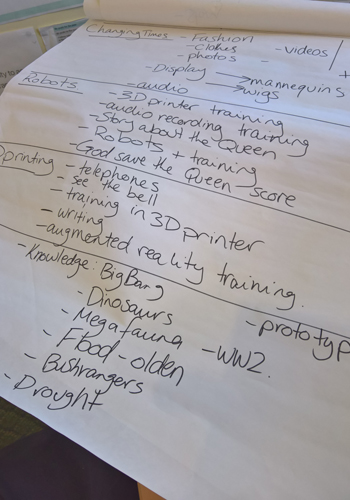Empathise, Define, Ideate, Repeat
26 February 2018
Today in the junior curator's workshop, we began the early stages of planning for our exhibition. Today was all about laying the important foundations for the exhibition. It also involved a lot of coloured texters and really big sheets of paper. That’s because today was mostly about EMPATHY, DEFINE and IDEATE.
In Design Thinking, Empathise is the first stage in the design process.

Image source: Nielsen Norman Group, Design Thinking 101
To begin with, we did a small exercise in empathy. It was a simple task of brainstorming who might be our audience for the exhibition. With a museum like the Museum of the Riverina, it is really easy to be dismissive and say ‘everyone’. This is true, but I really wanted the kids to break down into smaller groups and to visualise ‘who’ that audience really is. We came up with a list that included tourists, family and relatives, different ages in our community, different backgrounds. We also talked about the need to be aware of who our audience is so that we can plan for access. Even thinking about height and what the needs are around height helped to foster the idea of empathy.
This was the simple list we came up with:

The junior curators then moved into their groups. They all have colour co-ordinated plastic pockets for their books and other sheets of paper or clippings that they may come across as they move ahead. Many of them will need a USB, so a plastic pocket is a good way to help them keep all of their exhibition notes together.
The next part was the fun part. They had used empathy to think about the audience and their needs. The main purpose of the exercise was the encourage them to understand this was not a project just for their peers or their teachers and parents. It was for the community. The next stage was to be given their problems to define what they needed to achieve. They read through their problems and then we had them IDEATE as many ideas as possible. No budget, no known restrictions... if you could do anything to solve this problem, what would you do? Some ideas were practical, while others more imaginative. However, there are no right or wrong answers. The important thing is to think widely and communicate these ideas. The walking tour group discussed attaching a VR (Virtual Reality) camera to a robot and filming the tour so that visitors to the museum with limited mobility could still participate. The 3D printing group talked about recreating a timeline of important objects, such as telephones or writing implements. It was a great session with lots of great ideas and robust discussions.
After each group had made a short presentation to the group about their ideas, they then moved back into the DEFINE stage of the process. This helped them to narrow down their thoughts and make some decisions as a group. A worksheet asked them a series of simple questions: Who, What, Where, When, Why and How? Sometimes this question sequence is used for interrogating historical sources, but I’ve also found it useful for thinking about exhibition content.
WHO is the audience?
WHAT is your exhibit topic?
WHERE will it be displayed (online, framed images, plinths)?
WHEN are the time periods your exhibit interprets?
WHY is this interesting?
HOW will you display it?
Having defined the basis of their project moving forward, they created a list of what they need. So I was left with a short list of topics, training, programs, hardware, software that they need to equip themselves with to move forward, which looks something like this:
